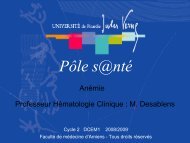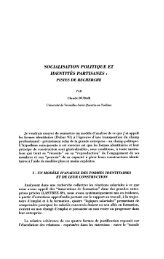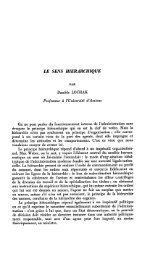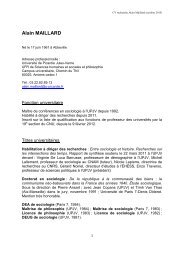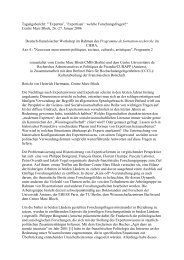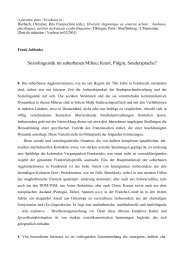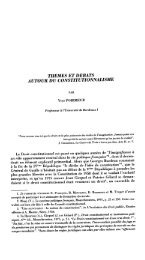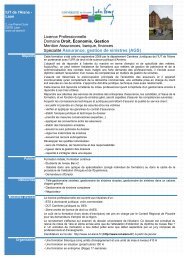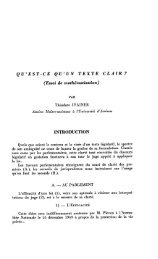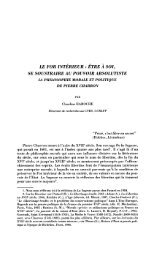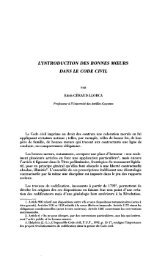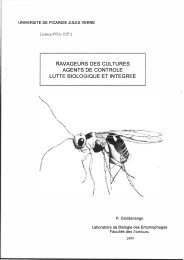Mirrors in the air: mirages in nature and in the laboratory
Mirrors in the air: mirages in nature and in the laboratory
Mirrors in the air: mirages in nature and in the laboratory
Create successful ePaper yourself
Turn your PDF publications into a flip-book with our unique Google optimized e-Paper software.
<strong>Mirrors</strong> <strong>in</strong> <strong>the</strong> <strong>air</strong>: <strong>mirages</strong> <strong>in</strong><br />
<strong>nature</strong> <strong>and</strong> <strong>in</strong> <strong>the</strong> <strong>laboratory</strong><br />
M Vollmer<br />
University of Applied Sciences Br<strong>and</strong>enburg, Germany<br />
Abstract<br />
Although mostly not perceived consciously, <strong>mirages</strong> are very familiar<br />
phenomena of everyday life. They can generally occur if light is <strong>in</strong>cident on<br />
media with a gradient of refractive <strong>in</strong>dex. This article starts with <strong>the</strong> easiest<br />
mirage effect, known as astronomical refraction, <strong>the</strong>n presents examples for<br />
<strong>in</strong>ferior <strong>and</strong> superior multiple image <strong>mirages</strong>, <strong>and</strong> f<strong>in</strong>ally focuses on<br />
demonstration experiments for <strong>the</strong> classroom.<br />
If you love <strong>nature</strong>, you respond to her<br />
phenomena as naturally as you brea<strong>the</strong><br />
.... Never th<strong>in</strong>k that <strong>the</strong> poetry of<br />
<strong>nature</strong>’s moods <strong>in</strong> all <strong>the</strong>ir <strong>in</strong>f<strong>in</strong>ite variety<br />
is lost on <strong>the</strong> scientific observer, for<br />
<strong>the</strong> habit of observ<strong>in</strong>g ref<strong>in</strong>es our sense<br />
of beauty <strong>and</strong> adds a brighter hue to<br />
<strong>the</strong> richly coloured background aga<strong>in</strong>st<br />
which each particular fact is outl<strong>in</strong>ed.<br />
These words of Marcel M<strong>in</strong>naert <strong>in</strong> <strong>the</strong><br />
preface of his famous book Light <strong>and</strong> Colour <strong>in</strong> <strong>the</strong><br />
Outdoors of 1937 [1] expressed his feel<strong>in</strong>gs when<br />
observ<strong>in</strong>g <strong>nature</strong>. Atmospheric optics offers a<br />
huge variety of natural phenomena [1–4]. Many of<br />
<strong>the</strong>se phenomena can be observed nearly every day<br />
<strong>and</strong> everywhere. Examples are ra<strong>in</strong>bows, halos,<br />
<strong>mirages</strong>, coronas (e.g. [5, 6]), glories, <strong>the</strong> colours<br />
of <strong>the</strong> sky, sunsets <strong>and</strong> twilight phenomena, <strong>and</strong><br />
green flashes; <strong>and</strong> <strong>the</strong>re are many more.<br />
All <strong>the</strong>se different phenomena are due to <strong>the</strong><br />
<strong>in</strong>teraction of light with matter that is present <strong>in</strong> <strong>the</strong><br />
atmosphere. Mirages belong to <strong>the</strong> most simple<br />
phenomena s<strong>in</strong>ce <strong>the</strong>y are due to pure <strong>air</strong>, i.e. <strong>air</strong><br />
consist<strong>in</strong>g of gases only (N2, O2, Ar,CO2, etc)<br />
but no water droplets, ice crystals, or aerosols.<br />
They occur if light waves propagate <strong>in</strong> gases with<br />
gradients <strong>in</strong> <strong>the</strong> <strong>in</strong>dex of refraction.<br />
F EATURES<br />
www.iop.org/journals/physed<br />
Index of refraction of <strong>air</strong><br />
In general, light which is propagat<strong>in</strong>g <strong>in</strong> pure <strong>air</strong><br />
is partly scattered accord<strong>in</strong>g to Rayleigh scatter<strong>in</strong>g<br />
(from molecules <strong>and</strong> atoms with<strong>in</strong> <strong>the</strong> <strong>air</strong>), <strong>the</strong> rest<br />
propagat<strong>in</strong>g undisturbed <strong>in</strong> <strong>the</strong> forward direction.<br />
The scattered light consists of sideways scatter<strong>in</strong>g<br />
light <strong>and</strong> forward scatter<strong>in</strong>g light, <strong>the</strong> latter be<strong>in</strong>g<br />
<strong>in</strong> phase with <strong>the</strong> <strong>in</strong>cident light. As a consequence,<br />
light <strong>in</strong> clear <strong>air</strong> is only slightly weakened<br />
by sideways scatter<strong>in</strong>g, <strong>the</strong> forward propagat<strong>in</strong>g<br />
light (be<strong>in</strong>g <strong>the</strong> superposition of <strong>in</strong>cident light<br />
<strong>and</strong> forward scattered light) dom<strong>in</strong>at<strong>in</strong>g. The<br />
weaken<strong>in</strong>g due to sideways scatter<strong>in</strong>g will not be<br />
discussed here: it leads to <strong>the</strong> blue sky <strong>and</strong> related<br />
phenomena.<br />
In terms of geometrical optics, <strong>the</strong> forward<br />
propagation of light <strong>in</strong> homogeneous media is<br />
usually expressed us<strong>in</strong>g <strong>the</strong> refractive <strong>in</strong>dex n (for<br />
tables of n, see[7]) <strong>and</strong> <strong>the</strong> law of refraction. n<br />
depends on <strong>the</strong> temperature T (<strong>in</strong> K), pressure p<br />
(<strong>in</strong> hPa), <strong>and</strong> humidity. Figure 1 depicts some<br />
examples. Differences due to <strong>the</strong> typical humidity<br />
of <strong>the</strong> <strong>air</strong> only amount to about 10 −6 compared to<br />
dry <strong>air</strong> at <strong>the</strong> same atmospheric conditions, <strong>and</strong> are<br />
neglected here.<br />
Neglect<strong>in</strong>g dispersion, equation (1) gives an<br />
approximation for <strong>the</strong> real part of <strong>the</strong> <strong>in</strong>dex of<br />
refraction n of dry <strong>air</strong> (its imag<strong>in</strong>ary part is almost<br />
zero <strong>in</strong> <strong>the</strong> visible region, s<strong>in</strong>ce absorption features<br />
0031-9120/09/020165+10$30.00 © 2009 IOP Publish<strong>in</strong>g Ltd P HYSICS E DUCATION 44 (2) 165
M Vollmer<br />
<strong>in</strong>dex of refraction<br />
1.00034<br />
1.00032<br />
1.00030<br />
1.00028<br />
1.00026<br />
dry <strong>air</strong><br />
0°C<br />
15°C<br />
30°C<br />
200 400 600 800<br />
wavelength <strong>in</strong> nm<br />
1000<br />
Figure 1. Real part of <strong>the</strong> <strong>in</strong>dex of refraction for dry<br />
<strong>air</strong> as a function of wavelength.<br />
of <strong>air</strong> will only occur <strong>in</strong> <strong>the</strong> ultraviolet (N2, O2) or<br />
<strong>in</strong>frared (CO2)).<br />
n = 1 + 77.6p<br />
T 10−6 . (1)<br />
For example, T = 300 K <strong>and</strong> p =<br />
1030 hPa yield n ≈ 1.000 266. Increas<strong>in</strong>g <strong>the</strong><br />
<strong>air</strong> temperature by 40 K (e.g. <strong>air</strong>, directly above<br />
<strong>the</strong> ground which is heated by <strong>the</strong> Sun) gives<br />
n ≈ 1.000 235. Such small changes (here �n ≈<br />
3 × 10−5 ) are responsible for all k<strong>in</strong>ds of mirage.<br />
Atmospheric refraction <strong>in</strong> astronomy<br />
The most simple mirage effect is known from<br />
astronomy: if an observer looks at an object <strong>in</strong><br />
<strong>the</strong> sky at a certa<strong>in</strong> altitude, <strong>the</strong> actual position<br />
vacuum<br />
n = 1.0<br />
refraction<br />
<strong>air</strong>: n = 1.000266<br />
refraction <strong>in</strong> arc seconds<br />
2400<br />
1800<br />
1200<br />
600<br />
0<br />
0<br />
10 20 30 40 50 60 70 80 90<br />
zenith distance <strong>in</strong> degrees<br />
Figure 3. Astronomical refraction of st<strong>and</strong>ard<br />
atmosphere as a function of zenith distance.<br />
30<br />
20<br />
10<br />
refraction <strong>in</strong> arc m<strong>in</strong>utes<br />
of <strong>the</strong> object is lower <strong>in</strong> <strong>the</strong> sky. This is due<br />
to <strong>the</strong> refraction of light upon propagation <strong>in</strong> <strong>the</strong><br />
atmosphere with a gradient of n, giv<strong>in</strong>g rise to<br />
curved light paths (figure 2).<br />
For <strong>the</strong> st<strong>and</strong>ard atmosphere, refraction is<br />
tabulated (e.g. [8]). In <strong>the</strong> zenith, <strong>the</strong> deviation<br />
is zero; at 45 ◦ zenith distance it amounts to 1 ′<br />
(1 m<strong>in</strong>ute of arc) <strong>in</strong>creas<strong>in</strong>g to more than 34 ′ at an<br />
angle of 90 ◦ (tangentially <strong>in</strong>cident light). Figure 3<br />
depicts refraction as a function of zenith distance.<br />
The maximum value of refraction has to<br />
be compared with <strong>the</strong> angular sizes of <strong>the</strong> Sun<br />
or Moon, which are about 30 ′ , i.e. half a<br />
degree. S<strong>in</strong>ce <strong>the</strong> refraction is 34 ′ at a zenith<br />
distance of 90 ◦ , but only about 28 ′ at a zenith<br />
distance of 89.5 ◦ , <strong>the</strong> Sun or <strong>the</strong> Moon <strong>in</strong> an<br />
o<strong>the</strong>rwise undisturbed atmosphere (no <strong>in</strong>version<br />
apparent direction<br />
refraction<br />
actual direction<br />
Figure 2. Two geometries for <strong>the</strong> atmosphere lead<strong>in</strong>g to astronomical refraction. With<strong>in</strong> an atmosphere of<br />
constant density, i.e. constant <strong>in</strong>dex of refraction, any light ray <strong>in</strong>cident from space is refracted. The<br />
respective angular deflection is called refraction. It is calculated more realistically if <strong>the</strong> density <strong>and</strong> <strong>in</strong>dex of<br />
refraction <strong>in</strong>crease <strong>in</strong> a series of layers from top to bottom (due to ei<strong>the</strong>r T or p changes). An <strong>in</strong>cident light<br />
ray will follow a polygon-like path. For <strong>in</strong>f<strong>in</strong>itesimally small layer thickness, this leads to curved light paths.<br />
Δx<br />
n1<br />
n2 > n1<br />
n3 > n2<br />
n4 > n3<br />
n5 > n4<br />
166 P HYSICS E DUCATION March 2009
horizon<br />
Sun, geometrically<br />
just below <strong>the</strong> horizon<br />
observation at sea level:<br />
large refraction, Sun<br />
just above <strong>the</strong> horizon<br />
Earth<br />
Figure 4. The Sun is flattened close to <strong>the</strong> horizon<br />
due to <strong>the</strong> change of astronomical refraction with<br />
zenith angle (see figure 3).<br />
layers) will thus be flattened (see figures 4<br />
<strong>and</strong> 5).<br />
Fur<strong>the</strong>rmore, <strong>the</strong> Sun or Moon can still be<br />
seen above <strong>the</strong> horizon although geometrically<br />
<strong>the</strong>y are already below <strong>the</strong> horizon while sett<strong>in</strong>g.<br />
The flatten<strong>in</strong>g effect can be nearly twice as large if<br />
<strong>the</strong> Moon is seen through a twice as long optical<br />
path through <strong>the</strong> atmosphere.<br />
Inferior <strong>mirages</strong><br />
Mirages are images of objects which may be seen<br />
<strong>in</strong> addition to real objects whenever <strong>the</strong>re are<br />
temperature differences <strong>in</strong> <strong>the</strong> atmosphere, which<br />
give rise to unusual gradients <strong>in</strong> <strong>the</strong> <strong>in</strong>dex of<br />
refraction (effects due to pressure variations are<br />
much smaller), result<strong>in</strong>g <strong>in</strong> curved light paths. If<br />
warm <strong>air</strong> is above <strong>the</strong> ground, n is smaller close to<br />
<strong>the</strong> ground than above it. This leads to <strong>in</strong>ferior<br />
<strong>mirages</strong> like <strong>the</strong> well-known wet-look<strong>in</strong>g streets<br />
<strong>Mirrors</strong> <strong>in</strong> <strong>the</strong> <strong>air</strong>: <strong>mirages</strong> <strong>in</strong> <strong>nature</strong> <strong>and</strong> <strong>in</strong> <strong>the</strong> <strong>laboratory</strong><br />
1<br />
3<br />
2<br />
Figure 6. Inferior <strong>mirages</strong>. Whenever <strong>the</strong> ground is<br />
warmer than <strong>the</strong> <strong>air</strong> above it, <strong>the</strong> <strong>in</strong>dex of refraction<br />
is lower close to <strong>the</strong> ground. Therefore light rays will<br />
follow curved paths as shown (a) from ray trac<strong>in</strong>g<br />
results for a number of light rays scattered from a<br />
palm tree. Some of <strong>the</strong>m will hit <strong>the</strong> ground (not<br />
shown), some will pass above or below <strong>the</strong> head of<br />
<strong>the</strong> observer, <strong>and</strong> some of <strong>the</strong>m (ray 4) may also<br />
bend such that <strong>the</strong>y reach <strong>the</strong> observer’s eye com<strong>in</strong>g<br />
from below. In this case, two light rays (rays 2 <strong>and</strong><br />
4) orig<strong>in</strong>ate from <strong>the</strong> same spot of <strong>the</strong> object but<br />
come from different directions. This is <strong>in</strong>terpreted <strong>in</strong><br />
<strong>the</strong> bra<strong>in</strong> as an object with a mirror image, as <strong>in</strong> (b).<br />
Note that bundles of light rays are needed <strong>in</strong> order to<br />
produce images. For <strong>the</strong> sake of simplicity, we will<br />
always speak of light rays, mean<strong>in</strong>g bundles of light<br />
rays.<br />
Figure 5. The Sun is flattened near <strong>the</strong> horizon close to sunset (Photo M Vollmer) <strong>and</strong> <strong>the</strong> Moon seen through<br />
nearly twice <strong>the</strong> atmosphere from <strong>the</strong> ISS (Photo D Pettit, 28 April 2003, with k<strong>in</strong>d permission of NASA).<br />
March 2009 P HYSICS E DUCATION 167<br />
(a)<br />
(b)<br />
5<br />
4
M Vollmer<br />
Figure 7. Typical <strong>in</strong>ferior mirage, observed on a hot summer street. Such <strong>mirages</strong> can be seen nearly every day<br />
while driv<strong>in</strong>g a car, when <strong>the</strong> Sun sh<strong>in</strong>es for a long time on paved streets. (Photo E Tränkle, reproduced with k<strong>in</strong>d<br />
permission.)<br />
Figure 8. Inferior mirage observed on <strong>the</strong> Wannsee <strong>in</strong> Berl<strong>in</strong>. The water had already warmed up <strong>in</strong> early spr<strong>in</strong>g<br />
before cold arctic <strong>air</strong> was rush<strong>in</strong>g <strong>in</strong>. As a result, a normal boat seems to look like a ‘sea daemon’. (Photo<br />
ETränkle, reproduced with k<strong>in</strong>d permission.)<br />
on hot summer days. The formation of <strong>in</strong>ferior<br />
<strong>mirages</strong> is illustrated <strong>in</strong> figure 6.<br />
Some examples from observations <strong>in</strong> everyday<br />
life <strong>and</strong> <strong>nature</strong> are shown <strong>in</strong> figures 7 <strong>and</strong> 8.<br />
The angular size of <strong>mirages</strong> is usually<br />
about 0.5 ◦ –1 ◦ . For observations, b<strong>in</strong>oculars <strong>and</strong><br />
cameras with telephoto lenses are used. The<br />
<strong>mirages</strong> are often distorted <strong>and</strong> flicker<strong>in</strong>g due<br />
to local density fluctuations <strong>in</strong> <strong>the</strong> <strong>air</strong>. This is<br />
very similar to <strong>the</strong> flicker<strong>in</strong>g of stars at night,<br />
seen through <strong>the</strong> atmosphere. Therefore, it<br />
is not possible to get really ‘focused’ mirage<br />
photographs.<br />
Invisible objects: <strong>the</strong> vanish<strong>in</strong>g l<strong>in</strong>e<br />
A prom<strong>in</strong>ent feature of a mirage is <strong>the</strong> so-called<br />
vanish<strong>in</strong>g l<strong>in</strong>e of <strong>the</strong> object [2]. Light below<br />
certa<strong>in</strong> object po<strong>in</strong>ts has no chance whatsoever of<br />
reach<strong>in</strong>g <strong>the</strong> eye of <strong>the</strong> observer, i.e. parts of <strong>the</strong><br />
object cannot be seen, irrespective of <strong>the</strong> direction<br />
<strong>in</strong>to which <strong>the</strong> light is scattered (see figure 9).<br />
The concept of vanish<strong>in</strong>g l<strong>in</strong>es expla<strong>in</strong>s why<br />
<strong>mirages</strong> often show <strong>in</strong>complete images of objects,<br />
which often makes it difficult to decide what is<br />
actually be<strong>in</strong>g observed. Figure 10 depicts two<br />
photographs taken close to <strong>the</strong> coast of <strong>the</strong> North<br />
Sea <strong>in</strong> Germany.<br />
168 P HYSICS E DUCATION March 2009
(a) (b)<br />
Figure 9. Vanish<strong>in</strong>g l<strong>in</strong>e <strong>in</strong> <strong>in</strong>ferior <strong>mirages</strong> (after<br />
[2]). For each light ray start<strong>in</strong>g at <strong>the</strong> palm tree <strong>in</strong><br />
every possible direction, ray trac<strong>in</strong>g is used to follow<br />
<strong>the</strong> curved trajectories. All object po<strong>in</strong>ts below a<br />
critical l<strong>in</strong>e, here at <strong>the</strong> ape position, are <strong>in</strong>visible to<br />
<strong>the</strong> observer, s<strong>in</strong>ce <strong>the</strong>re is no possibility that light<br />
can take an allowed path to connect <strong>the</strong>se po<strong>in</strong>ts with<br />
<strong>the</strong> eye of <strong>the</strong> observer.<br />
Quantitative modell<strong>in</strong>g of vanish<strong>in</strong>g l<strong>in</strong>e<br />
effects may be done via ray trac<strong>in</strong>g with<br />
computers. The various methods differ <strong>in</strong> <strong>the</strong>ir<br />
choice of geometry <strong>and</strong> profile n(h) for <strong>the</strong> <strong>in</strong>dex<br />
of refraction as a function of height above ground.<br />
<strong>Mirrors</strong> <strong>in</strong> <strong>the</strong> <strong>air</strong>: <strong>mirages</strong> <strong>in</strong> <strong>nature</strong> <strong>and</strong> <strong>in</strong> <strong>the</strong> <strong>laboratory</strong><br />
Figure 11 depicts an example <strong>in</strong> which <strong>the</strong> object<br />
is a car, seen from a height of 1 m, <strong>and</strong> at distances<br />
from 600 m to 3 km for a chosen profile n(h).<br />
The vanish<strong>in</strong>g l<strong>in</strong>e effect shows up <strong>in</strong><br />
figure 11: for distances larger than 1.2 km, <strong>the</strong><br />
tyres are no longer visible, <strong>and</strong> above 2.2 km<br />
<strong>the</strong> headlights are gone, too. A comparison<br />
with observations gives qualitatively reasonable<br />
agreement, as can be seen <strong>in</strong> figure 12 (typical<br />
problems while observ<strong>in</strong>g are that one is proud of<br />
gett<strong>in</strong>g a nice shot with a camera but one lacks<br />
knowledge of <strong>the</strong> distance of an approach<strong>in</strong>g car).<br />
Superior <strong>mirages</strong><br />
Sometimes <strong>in</strong>version layers are present <strong>in</strong> <strong>the</strong><br />
atmosphere: <strong>the</strong> <strong>air</strong> at a given height is warmer<br />
than that below (<strong>and</strong> above), i.e., its <strong>in</strong>dex of<br />
refraction is lower than that above or below this<br />
height. This situation favours <strong>the</strong> observations of<br />
superior <strong>mirages</strong> (figure 13). Figure 14 gives an<br />
example of a fasc<strong>in</strong>at<strong>in</strong>g superior mirage, observed<br />
<strong>in</strong> F<strong>in</strong>l<strong>and</strong>.<br />
Figure 10. A church on <strong>the</strong> isl<strong>and</strong> of Pellworm, seen from <strong>the</strong> Hallig Hooge at high tide, <strong>and</strong> an <strong>in</strong>ferior mirage of<br />
it, seen from a distance of more than 11 km over mudflats at low tide. (Photos M Vollmer). The vanish<strong>in</strong>g l<strong>in</strong>e is<br />
just below <strong>the</strong> roof of <strong>the</strong> build<strong>in</strong>g beside <strong>the</strong> tower. Therefore some higher-ly<strong>in</strong>g parts of Pellworm seem to float <strong>in</strong><br />
<strong>the</strong> <strong>air</strong> <strong>and</strong> <strong>the</strong>ir base cannot be observed. The <strong>in</strong>ferior mirage is a triple mirage image due to slightly more<br />
complex atmospheric conditions close to <strong>the</strong> ground.<br />
Figure 11. Theoretical <strong>in</strong>ferior mirage of an object (car, left side). The observer’s eye is at 1 m <strong>and</strong> <strong>the</strong><br />
distance <strong>in</strong> km varies (from left to right): 0.6, 0.7, 0.8, 0.9, 1.0, 1.2, 1.4, 1.6, 1.8, 2.0, 2.2, 2.6, 2.8 <strong>and</strong> 3.0.<br />
(Simulation by E Tränkle, reproduced with k<strong>in</strong>d permission.)<br />
March 2009 P HYSICS E DUCATION 169
M Vollmer<br />
Figure 12. Some road <strong>in</strong>ferior <strong>mirages</strong>, which resemble some of <strong>the</strong> <strong>the</strong>oretically expected features of figure 11.<br />
The photographs were taken <strong>in</strong> Namibia close to Walvis Bay (Photos M Vollmer).<br />
height<br />
temperature<br />
<strong>in</strong>dex of refraction<br />
apparent<br />
size of object<br />
Figure 13. Superior <strong>mirages</strong> can occur if <strong>in</strong>version layers are present <strong>in</strong> <strong>the</strong> atmosphere. The light rays from<br />
<strong>the</strong> top leaf of a palm tree can follow many different curved paths to reach <strong>the</strong> eye of an observer. Some light<br />
rays can enter <strong>the</strong> eye from quite large observation angles, i.e. an observer sees an image of an object which is<br />
vertically stretched (called tower<strong>in</strong>g).<br />
Magic of <strong>the</strong> <strong>air</strong>: three-fold mirage images<br />
When study<strong>in</strong>g <strong>the</strong> huge variety of vertical profiles<br />
for <strong>the</strong> <strong>in</strong>dex of refraction, it becomes obvious that<br />
a multitude of possible mirage effects is possible.<br />
In some cases (see e.g. [2]) <strong>the</strong> paths of light from<br />
objects—as governed by <strong>the</strong> law of refraction—<br />
can even give rise to multiple images on top of <strong>the</strong><br />
object. Figure 15 depicts possible light paths from<br />
an object (here <strong>the</strong> letter F) <strong>in</strong> a situation which<br />
resembles <strong>in</strong>version layers <strong>in</strong> <strong>the</strong> atmosphere.<br />
The top of <strong>the</strong> letter F may, for example, be<br />
seen us<strong>in</strong>g light bundles 2, 3, or 5, all enter<strong>in</strong>g<br />
<strong>the</strong> eye of <strong>the</strong> observer at different angles, thus<br />
lead<strong>in</strong>g to a three-fold image. The first wellknown<br />
natural <strong>mirages</strong> of this type were reported<br />
<strong>in</strong> 1798 by Reverend V<strong>in</strong>ce. Look<strong>in</strong>g at <strong>the</strong> North<br />
170 P HYSICS E DUCATION March 2009
<strong>Mirrors</strong> <strong>in</strong> <strong>the</strong> <strong>air</strong>: <strong>mirages</strong> <strong>in</strong> <strong>nature</strong> <strong>and</strong> <strong>in</strong> <strong>the</strong> <strong>laboratory</strong><br />
Figure 14. Superior mirage, observed <strong>in</strong> Kustavi <strong>in</strong> a lake area <strong>in</strong> <strong>the</strong> southwest of F<strong>in</strong>l<strong>and</strong>. Portions of distant l<strong>and</strong><br />
are vertically stretched <strong>and</strong> appear as wall-like objects. In <strong>the</strong> middle, part of <strong>the</strong> distant l<strong>and</strong> is hidden (similar to<br />
<strong>the</strong> vanish<strong>in</strong>g l<strong>in</strong>e effect of figure 9) giv<strong>in</strong>g rise to a ‘bridge’-like structure. The maximum angular height of <strong>the</strong><br />
mirage is governed by <strong>the</strong> distance of <strong>the</strong> object <strong>and</strong> <strong>the</strong> height of <strong>the</strong> <strong>in</strong>version layer. (Photo Pekka Parvia<strong>in</strong>en.)<br />
Many more spectacular photographs of <strong>mirages</strong> <strong>and</strong> o<strong>the</strong>r optical phenomena can be found at [9].<br />
5<br />
4<br />
2<br />
1<br />
Figure 15. Light paths lead<strong>in</strong>g to three-image<br />
superior <strong>mirages</strong>.<br />
3<br />
Sea he observed very strange <strong>mirages</strong> of sailboats<br />
for hours. Some of his sketches are shown <strong>in</strong><br />
figure 16.<br />
Demonstration experiments<br />
Several experiments can be used to illustrate <strong>the</strong><br />
concepts of <strong>mirages</strong> while teach<strong>in</strong>g. These <strong>in</strong>clude<br />
demonstrations of curved light paths as well as<br />
<strong>in</strong>ferior <strong>and</strong> superior <strong>mirages</strong> [4, 11–14]. Inferior<br />
<strong>mirages</strong> were already simulated nearly 100 years<br />
ago. In <strong>nature</strong>, <strong>the</strong>y are observed over distances<br />
of hundreds of metres to kilometres. Typical<br />
<strong>laboratory</strong> dimensions are smaller by about a<br />
factor of 1000; hence, <strong>the</strong> temperature differences<br />
must be higher <strong>and</strong> <strong>the</strong> objects smaller. Usually,<br />
a plate of metal (1–2 m long) is heated (e.g. by<br />
gas flames, which by itself is a spectacular<br />
demonstration). Cover<strong>in</strong>g <strong>the</strong> plate with a layer<br />
of s<strong>and</strong> ensures that no actual reflections from <strong>the</strong><br />
metal are possible. Figure 17 depicts a mirage seen<br />
5<br />
4<br />
3<br />
2<br />
1<br />
above such a hot plate. In this case, <strong>the</strong> object was<br />
a toy car (for o<strong>the</strong>r examples, see [4, 11]).<br />
The curvature of light paths as well as<br />
superior <strong>mirages</strong> can be demonstrated very easily<br />
<strong>in</strong> liquids with a gradient of <strong>the</strong> <strong>in</strong>dex of<br />
refraction [4, 11, 12]. The equipment needed<br />
consists only of a water tank (typical dimensions<br />
10 cm × 30 cm × 20 cm height), a light beam<br />
(for example from a He–Ne laser or, more cheaply,<br />
a laser po<strong>in</strong>ter) as well as layered sugar or salt<br />
solutions.<br />
The solutions may be prepared <strong>in</strong> a variety<br />
of ways. In <strong>the</strong> follow<strong>in</strong>g, only <strong>the</strong> procedure<br />
for <strong>the</strong> salt solution is described. Ei<strong>the</strong>r fresh<br />
water is placed on top of a saturated salt solution<br />
(for example, by plac<strong>in</strong>g a th<strong>in</strong> foil on top of <strong>the</strong><br />
salt solution which is later cautiously removed)<br />
or a saturated salt solution is placed below <strong>the</strong><br />
fresh water layer (for example, by means of a<br />
regulated flow through a th<strong>in</strong> rubber tube, end<strong>in</strong>g<br />
at <strong>the</strong> bottom of <strong>the</strong> tank). In both cases it is<br />
possible to generate <strong>the</strong> layered systems without<br />
much mix<strong>in</strong>g, by carefully avoid<strong>in</strong>g turbulence<br />
<strong>and</strong> vibrations when fill<strong>in</strong>g <strong>the</strong> tank.<br />
After preparation, <strong>the</strong> two liquids slowly mix<br />
via diffusion processes, result<strong>in</strong>g <strong>in</strong> a gradient<br />
of <strong>the</strong> <strong>in</strong>dex of refraction between <strong>the</strong> saturated<br />
salt solution (n ≈ 1.364) <strong>and</strong> pure water (n ≈<br />
1.332) at λ = 632.8 nm. Therefore, this setup<br />
qualitatively resembles an <strong>in</strong>version layer <strong>in</strong><br />
<strong>the</strong> atmosphere, where warm <strong>air</strong> (smaller n) is<br />
above colder <strong>air</strong> (larger n). The water tank<br />
March 2009 P HYSICS E DUCATION 171
M Vollmer<br />
Figure 16. Two-fold <strong>and</strong> three-fold superior mirage images, observed on 1 August 1798 by Reverend S V<strong>in</strong>ce <strong>in</strong><br />
Ramsgate (after [10]).<br />
Figure 17. Inferior mirage <strong>in</strong> <strong>the</strong> <strong>laboratory</strong> us<strong>in</strong>g a<br />
1.8 m long metal plate, covered by s<strong>and</strong> <strong>and</strong> heated<br />
us<strong>in</strong>g gas flames.<br />
should not be exposed to vibrations, s<strong>in</strong>ce rapid<br />
diffusion decreases <strong>the</strong> period for observations.<br />
Without disturb<strong>in</strong>g <strong>the</strong> solution, experiments for<br />
demonstration of curved light beams may be<br />
performed for a couple of hours, those of three<br />
part superior <strong>mirages</strong> (see below) for even longer<br />
times, <strong>and</strong> some mirage distortions like tower<strong>in</strong>g<br />
or stoop<strong>in</strong>g may be seen for one or two days.<br />
After preparation of <strong>the</strong> layered liquids<br />
<strong>in</strong> <strong>the</strong> tank, <strong>the</strong> curvature of a laser beam<br />
<strong>in</strong> <strong>the</strong> <strong>in</strong>homogeneous solution can be easily<br />
demonstrated by illum<strong>in</strong>at<strong>in</strong>g from below <strong>and</strong><br />
vary<strong>in</strong>g <strong>the</strong> angle of <strong>in</strong>cidence. Figure 18 depicts<br />
a photograph of a curved laser beam directed<br />
through <strong>the</strong> tank <strong>and</strong> viewed from <strong>the</strong> side.<br />
Even a horizontally <strong>in</strong>cident beam will be<br />
curved downward due to <strong>the</strong> vertical gradient of<br />
<strong>the</strong> <strong>in</strong>dex of refraction. This is due to <strong>the</strong> f<strong>in</strong>ite<br />
dimension at <strong>the</strong> beam waist: <strong>the</strong> upper <strong>and</strong> lower<br />
portions see different values of refractive <strong>in</strong>dex<br />
<strong>and</strong> will be bent differently. Consequently, <strong>the</strong><br />
whole ray will be curved.<br />
Once <strong>the</strong> solution is prepared <strong>and</strong> curved light<br />
paths are observed, one should also be able to<br />
observe superior <strong>mirages</strong> when look<strong>in</strong>g through<br />
<strong>the</strong> water tank. The size of <strong>the</strong> objects depends<br />
on <strong>the</strong> height of <strong>the</strong> salt solution <strong>and</strong> fresh water<br />
layers. Dimensions of several centimetres work<br />
172 P HYSICS E DUCATION March 2009
<strong>Mirrors</strong> <strong>in</strong> <strong>the</strong> <strong>air</strong>: <strong>mirages</strong> <strong>in</strong> <strong>nature</strong> <strong>and</strong> <strong>in</strong> <strong>the</strong> <strong>laboratory</strong><br />
Figure 18. A laser beam is illum<strong>in</strong>at<strong>in</strong>g a layered solution from below. It illustrates a curved light ray.<br />
well. Parameters for <strong>the</strong> observation are: relative<br />
height of <strong>the</strong> object <strong>and</strong> <strong>the</strong> boundary (diffusion)<br />
layer, <strong>the</strong> distance of <strong>the</strong> object beh<strong>in</strong>d <strong>the</strong> water<br />
tank, <strong>and</strong> <strong>the</strong> distance of <strong>the</strong> observer as well as<br />
<strong>the</strong> angle of <strong>in</strong>cidence of light rays with respect to<br />
<strong>the</strong> eye of <strong>the</strong> observer.<br />
Once <strong>the</strong> solution is prepared, optimum<br />
observation conditions are usually found with<strong>in</strong><br />
a few m<strong>in</strong>utes. For better results, one may<br />
illum<strong>in</strong>ate <strong>the</strong> objects <strong>and</strong> observe through <strong>the</strong><br />
smaller dimension (width) of typically 10 cm<br />
ra<strong>the</strong>r than <strong>the</strong> length of <strong>the</strong> tank. Depend<strong>in</strong>g<br />
on <strong>the</strong> observation angle, one can readily observe<br />
three-fold images (see figure 19).<br />
As mentioned above, <strong>in</strong> <strong>nature</strong>, typical<br />
dimensions are of <strong>the</strong> order of hundreds of metres,<br />
<strong>and</strong> changes of <strong>the</strong> <strong>in</strong>dex of refraction are of<br />
<strong>the</strong> order of several 10 −5 . In <strong>the</strong> water tank<br />
experiment, <strong>the</strong> distances are only of <strong>the</strong> order of<br />
10 cm, but this is compensated by <strong>the</strong> change of<br />
<strong>the</strong> <strong>in</strong>dex of refraction of <strong>the</strong> order of 10 −2 .<br />
Among <strong>the</strong> most fasc<strong>in</strong>at<strong>in</strong>g properties of<br />
<strong>mirages</strong> <strong>in</strong> <strong>nature</strong> are transient effects due to<br />
<strong>air</strong> fluctuations. They can be demonstrated by<br />
<strong>in</strong>troduc<strong>in</strong>g water turbulence: for example, by<br />
slowly stirr<strong>in</strong>g <strong>the</strong> system. Wavelike disturbances<br />
<strong>in</strong> <strong>the</strong> artificial <strong>in</strong>version layer lead to similar<br />
wavelike patterns <strong>in</strong> <strong>the</strong> <strong>mirages</strong>.<br />
More experiments<br />
More water tank experiments are possible us<strong>in</strong>g<br />
different liquids. Besides layered salt solutions,<br />
sugar solution also works very well [13], although<br />
it is more messy to clean up. However, sugar<br />
allows <strong>the</strong> preparation of multilayer solutions<br />
which can help to underst<strong>and</strong> more complex<br />
<strong>mirages</strong> <strong>in</strong> <strong>nature</strong>. Quite a few more complicated<br />
chemical recipes have also been reported <strong>in</strong> <strong>the</strong><br />
literature; however, most are with controlled<br />
substances which are not suited for teach<strong>in</strong>g<br />
purposes. Us<strong>in</strong>g <strong>the</strong> salt water tank set-up with <strong>the</strong><br />
three-image mirage, it is also possible to observe<br />
colourful effects from black <strong>and</strong> white objects<br />
which are due to dispersion effects with<strong>in</strong> <strong>the</strong><br />
artificial <strong>in</strong>version layer [14].<br />
In <strong>nature</strong>, one may also observe lateral<br />
<strong>mirages</strong>, for example, as <strong>mirages</strong> from heated<br />
walls. Experiments along <strong>the</strong>se l<strong>in</strong>es were realized<br />
<strong>in</strong> <strong>the</strong> <strong>laboratory</strong>, by us<strong>in</strong>g a U-shaped, flameheated<br />
channel [4, 14]. This allowed observation<br />
of three lateral images of <strong>the</strong> object.<br />
F<strong>in</strong>ally, it is possible to observe <strong>mirages</strong> with<br />
hot plates as small as 14 cm diameter, although<br />
<strong>the</strong> image effects are small. However, hot plates<br />
are also ideally suited to demonstrate what we<br />
might call <strong>the</strong> deflection of light beams by human<br />
breath [14]. A laser is set up to illum<strong>in</strong>ate a hot<br />
plate at graz<strong>in</strong>g <strong>in</strong>cidence such that some of its<br />
light is scattered by <strong>the</strong> surface. In addition, one<br />
also observes <strong>the</strong> position of <strong>the</strong> light beam on a<br />
distant wall. Blow<strong>in</strong>g onto <strong>the</strong> hot plate results<br />
<strong>in</strong> an easily observable upward deflection of <strong>the</strong><br />
beam spot on <strong>the</strong> wall while, simultaneously, <strong>the</strong><br />
scattered light on <strong>the</strong> surface of <strong>the</strong> plate is no<br />
longer visible.<br />
Acknowledgments<br />
Special thanks go to Pekka Parvia<strong>in</strong>en for lett<strong>in</strong>g<br />
me use his photograph (figure 14) <strong>and</strong> <strong>in</strong> particular<br />
March 2009 P HYSICS E DUCATION 173
M Vollmer<br />
Figure 19. A layered solution of fresh water above salt water resembles an artificial <strong>in</strong>version layer. It allows <strong>the</strong><br />
observation of three-fold <strong>mirages</strong> (bottom) of objects (top).<br />
to my former friend E Tränkle, who died much too<br />
early.<br />
Received 1 October 2008, <strong>in</strong> f<strong>in</strong>al form 20 November 2008<br />
doi:10.1088/0031-9120/44/2/008<br />
References<br />
[1] M<strong>in</strong>naert M G J 1993 Light <strong>and</strong> Color <strong>in</strong> <strong>the</strong><br />
Outdoors 1st edn (Berl<strong>in</strong>: Spr<strong>in</strong>ger) (<strong>in</strong> Dutch<br />
1937)<br />
[2] Greenler R 1980 Ra<strong>in</strong>bows, Halos, <strong>and</strong> Glories<br />
(Cambridge: Cambridge University Press)<br />
[3] Lynch D K <strong>and</strong> Liv<strong>in</strong>gston W 2001 Color <strong>and</strong><br />
Light <strong>in</strong> Nature 2nd edn (Cambridge:<br />
Cambridge University Press)<br />
[4] Vollmer M 2005 Lichtspiele <strong>in</strong> der Luft:<br />
Atmosphärische Optik für E<strong>in</strong>steiger<br />
(Spektrum-Elsevier)<br />
[5] Cowley L, Laven Ph <strong>and</strong> Vollmer M 2005 R<strong>in</strong>gs<br />
around <strong>the</strong> sun <strong>and</strong> moon: coronae <strong>and</strong><br />
diffraction Phys. Educ. 40 51–9<br />
[6] Cowley L T www.atoptics.co.uk<br />
[7] Penndorf R 1957 Tables of <strong>the</strong> refractive <strong>in</strong>dex for<br />
st<strong>and</strong>ard <strong>air</strong> <strong>and</strong> <strong>the</strong> Rayleigh scatter<strong>in</strong>g<br />
coefficient for <strong>the</strong> spectral region between 0.2<br />
<strong>and</strong> 20 μm <strong>and</strong> <strong>the</strong>ir application to<br />
atmospheric optics J. Opt. Soc. Am. 47 176<br />
[8] Tricker R A R 1970 Introduction to<br />
Meteorological Optics (New York: Elsevier)<br />
[9] Parvia<strong>in</strong>en P www.polarimage.fi<br />
[10] Pernter J M <strong>and</strong> Exner F M 1922 Meteorologische<br />
Optik 2 edn (Vienna: W Braumüller)<br />
[11] Greenler R 1987 Laboratory simulation of <strong>in</strong>ferior<br />
<strong>and</strong> superior <strong>mirages</strong> J. Opt. Soc. Am. A 4 589<br />
[12] Vollmer M <strong>and</strong> Tammer R 1998 Laboratory<br />
experiments <strong>in</strong> atmospheric optics Appl. Opt.<br />
37 1557<br />
[13] Tape C 2000 Aquarium, computer, <strong>and</strong> Alaska<br />
range <strong>mirages</strong> Phys. Teach. 38 308<br />
[14] Vollmer M <strong>and</strong> Greenler R 2003 Halo <strong>and</strong> mirage<br />
demonstrations <strong>in</strong> atmospheric optics Appl.<br />
Opt. 42 394<br />
Michael Vollmer is professor of physics<br />
at <strong>the</strong> University of Applied Sciences <strong>in</strong><br />
Br<strong>and</strong>enburg, Germany, work<strong>in</strong>g <strong>in</strong> <strong>the</strong><br />
fields of <strong>in</strong>frared <strong>the</strong>rmal imag<strong>in</strong>g,<br />
spectroscopy, atmospheric optics <strong>and</strong><br />
didactics of physics. Besides teach<strong>in</strong>g<br />
<strong>and</strong> research he is also <strong>in</strong>volved <strong>in</strong><br />
<strong>in</strong>-service-teacher tra<strong>in</strong><strong>in</strong>g.<br />
174 P HYSICS E DUCATION March 2009



